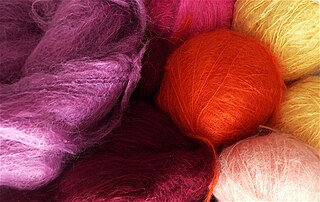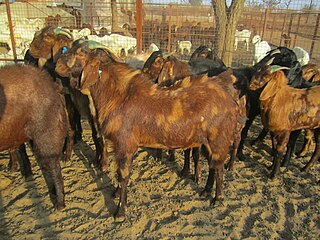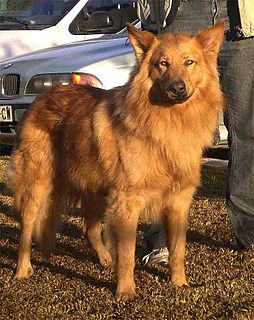Sources
- "Chigu Goat". Archived from the original on 22 December 2008.
- Goats by breed - Chigu
The Chigu goat breed, found north of Uttar Pradesh and northeast of Himachal Pradesh in India, is used for the production of meat and cashmere wool. The coat is usually white, mixed with grayish red. Both sexes have long twisted horns. Males body weight is approximately 40 kg, while females body weight is approximately 25 kg. Conformation is similar to Chanthangi. Live in mountainous ranges with the altitude varying from 3500 to 5000 m. This area is mostly cold and arid.

Mohair is a fabric or yarn made from the hair of the Angora goat. Both durable and resilient, mohair is notable for its high luster and sheen, and is often used in fiber blends to add these qualities to a textile. Mohair takes dye exceptionally well. It feels warm in winter as it has excellent insulating properties, while its moisture-wicking properties allow it to remain cool in summer. It is durable, naturally elastic, flame-resistant and crease-resistant. It is considered a luxury fiber, like cashmere, angora, and silk, and can be more expensive than most sheep's wool.

Cashmere wool, usually simply known as cashmere, is a fiber obtained from cashmere goats, pashmina goats, and some other breeds of goat. It has been used to make yarn, textiles and clothing for hundreds of years. Cashmere is closely associated with the Kashmir shawl, the word "cashmere" deriving from an anglicisation of Kashmir when the Kashmir shawl reached Europe in the 19th century from Colonial India. Common usage defines the fiber as wool, but it is finer, stronger, lighter, softer and approximately three times more insulating than sheep wool. Both the soft undercoat and the guard hairs may be used; the softer hair is reserved for textiles, while the coarse guard hair is used for brushes and other non-apparel purposes.

The Boer goat is a breed of goat that was developed in South Africa in the early 1900s and is a popular breed for meat production. Their name is derived from the Afrikaans (Dutch) word boer, meaning farmer.

The Nigerian Dwarf is an American breed of dwarf goat. Like the American Pygmy Goat, it derives from the West African Dwarf group of breeds of West Africa.

A cashmere goat is a type of goat that produces cashmere wool, the goat's fine, soft, downy, winter undercoat, in commercial quality and quantity. This undercoat grows as the day length shortens and is associated with an outer coat of coarse hair, which is present all the year and is called guard hair. Most common goat breeds, including dairy goats, grow this two-coated fleece.

The Pygora goat is a breed of goat that originated from crossing the registered NPGA Pygmy goat and the white AAGBA Angora goat. Pygoras, along with the Angora goat and Cashmere goat, are fiber goats. Pygora goats produce three distinct kinds of fleece.

The Orenburg shawl is a Russian knitted lace textile using goat down and stands as one of the classic symbols of Russian handicraft, along with Tula samovars, the Matrioshka doll, Khokhloma painting, Gzhel ceramics, the Palekh miniature, Vologda lace, Dymkovo toys, Rostov finift (enamel), and Ural malachite.

Animal fibers are natural fibers that consist largely of certain proteins. Examples include silk, hair/fur and feathers. The animal fibers used most commonly both in the manufacturing world as well as by the hand spinners are wool from domestic sheep and silk. Also very popular are alpaca fiber and mohair from Angora goats. Unusual fibers such as Angora wool from rabbits and Chiengora from dogs also exist, but are rarely used for mass production.

The Kinder is an American breed of domestic goat. It originated on a farm in Snohomish, Washington, where in about 1985 an American Pygmy buck was cross-bred with Nubian does. The resulting stock was selectively bred to create a compact but well-muscled goat, suitable both for milk and for meat production. A herd-book was started in 1988; by 2006 about three thousand head had been registered.

The Changthangi or Ladakh Pashmina is a breed of cashmere goat native to the high plateaux of Ladakh, India. The cold temperatures in the region are the primary factor in the growth of the fine pashmina grade of cashmere wool for which they are reared. It is also used as a pack animal and for meat.

The domestic goat or simply goat is a subspecies of C. aegagrus domesticated from the wild goat of Southwest Asia and Eastern Europe. The goat is a member of the animal family Bovidae and the subfamily Caprinae, meaning it is closely related to the sheep. There are over 300 distinct breeds of goat. It is one of the oldest domesticated species of animal, according to archaeological evidence that its earliest domestication occurred in Iran at 10,000 calibrated calendar years ago.
The Altai Mountain goat is a breed of domestic goat bred for wool production. The breed was developed during the years from 1944 to 1982 in the Gorno-Altai Autonomous Soviet Socialist Republic region of the Soviet Union, by cross-breeding the Don goat with local goats for a high wool yield.
The Zhongwei (Chung-wei) is a breed of goat from the Ningxia Hui Autonomous Region and Gansu Province of China. It lives on arid desert steppes, and is adapted to a diet of salty and sandy plants and shrubs. It is used primarily for the production of kid pelts, and secondarily for cashmere fiber. The breed has low genetic variability, likely due to the historic selection of pelt production traits. It is closely related to the Funiu White, Hexi Cashmere, Luliang Black, and Taihang breeds.
The Lohi sheep is found in southern Punjab in Pakistan and Rajasthan and Haryana in India. It is used for its carpet quality wool and meat production. The body is white and the head is usually tan, black or brown.

Ongole cattle is an indigenous cattle breed that originates from Prakasam District in the state of Andhra Pradesh in India. The breed derives its name from the place the breed originates from, Ongole. The Ongole breed of cattle, Bos Indicus, has a great demand as it is said to possess resistance to both foot and mouth disease and mad cow disease. These cattle are commonly used in bull fights in Mexico and some parts of East Africa due to their strength and aggressiveness. They also participate in traditional bull fights in Andhra Pradesh and Tamil Nadu. Cattle breeders use the fighting ability of the bulls to choose the right stock for breeding in terms of purity and strength.

The Sirohi is an Indian breed of domestic goat. It is named for its area of origin, the Sirohi District of Rajasthan, in north-western India. It may be described as a dual-purpose breed, reared for both meat and milk production, or as meat breed. It is well adapted to the dry tropical climate of Rajasthan.

The British primitive goat is a landrace of domestic goat native to Great Britain and Ireland, and is the original goat of the region. It is considered a rare breed, existing as several, isolated feral herds, as some captive populations in zoological parks and nature reserves, and breeding stock on some private farms operated by groups of rare-breed enthusiasts. As few as 1,200 individual British primitives may remain. The variety is also referred to as the British native goat, the old British goat, the old English goat or the British landrace goat, among more specific names It descends from the earliest goats brought to the region in the Neolithic era, around 3,000 BCE. It is classified in the Northern breed group of goats. A population in Northumbria is sometimes referred to as the Cheviot goat. The British primitive is among the foundation stock of some modern standardised breeds, including the Anglo-Nubian goat. The breed is comparatively small, with commensurately low milk production. It is hardy and wiry haired, adapted to rough terrain and weather, and able to subsist and breed on its own without human intervention.
The Aspromonte or Capra dell'Aspromonte is an indigenous breed of domestic goat from the mountain massif of the Aspromonte, in the province of Reggio Calabria in Calabria in southern Italy, for which it is named. It is raised only in the province of Reggio Calabria, mainly in the Aspromonte, in the Altipiano dello Zomaro to the north-east, and in the Ionian coastal areas of the province, and particularly in areas of Grecanic culture. While the breed is thought to originate on the Aspromonte, it may have been influenced by the various other goat breeds, including the Abyssinian goat, the Maltese, and a type known as "Tibetan" with long silky hair, whose importation to Calabria in the early twentieth century is well documented.

The Pastor Garafiano is a Spanish breed of sheep dog native to the island of La Palma in the Canary Islands. The name comes from the comarca of Garafía, in the north of the island, where the breed was most common, although specimens can be found throughout the island. The breed was officially recognized by the Real Sociedad Canina de España in 2003.

Goat farming involves the raising and breeding of domestic goats as a branch of animal husbandry. People farm goats principally for their meat, milk, fibre and skins.